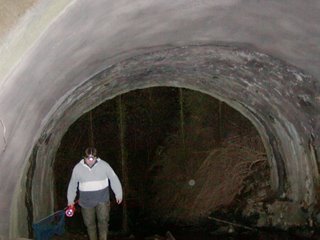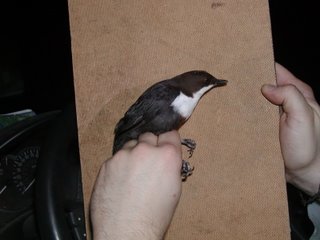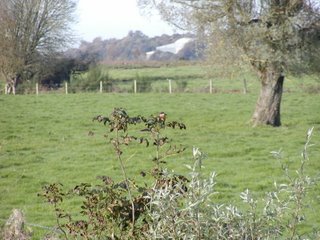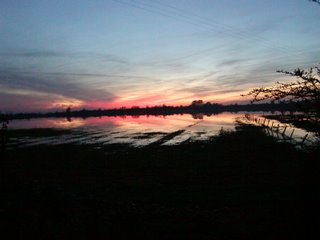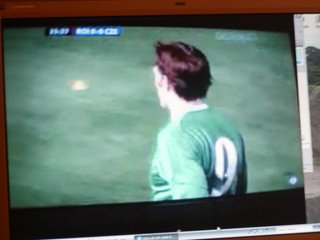Swansong
Hi folks,
What a day today! Today my car was due in for a service and new tyres. It's done a lot of hard mileage since April 1st (yeah, I know what day I arrived here.) Actually, I've not had it quite that long, I had to change my car when I got my window smashed by a 4x4 that was driving down the middle of the white line one Sunday Morning.
So, having exhausted my opportunities in the local community today, I went to a couple of beautiful old castle towers to help erect some Barn Owl boxes. I wish I had taken my camera. They were fantastic. I might even go back and get a photo for you. I'm sorry but my camera was in the car, the car was in for service....
We didn't so much "erect" these boxes, as climb up a pair of ladders and pop them on a ledge. Some of the ivy was like a tree-trunk, one had a 15 foot tree growing from one ledge, big enough for me to use in hauling this great bird box onto the ledge.
My colleague, John, is managing the Barn Owl Project and beginning a PhD study of the Barn Owl in Ireland, trying to determine the limits and requirements of each territory. Where a territory is found, John attempts to provide a range a nesting boxes, within and without the territory, so that nesting opportunities are available for both the adults, should they wish to relocate, and the successful brood, who may have to look in another county for an appropriate site. Actually, that probably doesn’t read quite right, recent studies suggest that here in Ireland suitable nesting habitat isn’t significant factor, that we may have a lot of suitable castles and similar old buildings which aren’t being used. There is a secondary reason for us to provide nest-boxes, they are easy to monitor, if we can put them up, then it is even easier to check them. Two years ago, I returned to England for training with my supervisor Dr Jim Fowler , who was supervising the bird-ringing aspects of the research at Muncaster Castle.
http://www.visitcumbria.com/wc/muncowl.htm
Birds that were nesting in Cumbria, which we visited, included pipes in walls more than 8 feet deep, water cisterns and tanks with open tops, holes into cavity walls and boxes, not easy nests to monitor, some of them. A bird-box is ideal, if they weren’t, then birds wouldn’t move into them.
So, if you know the whereabouts of a nesting (or roosting) Barn Owl in England or Ireland, please let me know, and I’ll let the folk know that need to know…. But we do need to know. You may think that you’re looking after them by keeping them private, but we can arrange first-rate nesting accommodation for their young in adjacent territories if we know where they are. First year breeders and inexperienced birds will always be more successful if they are assisted. The route to successful breeding in most birds is possibly littered with many failures. Early breeding success is key in any project of this nature, we need to turn things around quickly. When a species is in sharp decline, then it is probably obvious that we need to have a lot of chicks fledge, we need birds soon, now. In these British and Irish projects, we can assist the young birds whilst not disturbing the adults. If we are going to turn this decline around then we have got to help the experienced breeding pairs as well as the new generation. So, please inform the local agencies of myself directly if you know the whereabouts of a breeding or roosting Barn Owl.
I'm sorry if you're still looking for the swan, but I took it out, it was kinda sad.
Slainté,
Davy
www.flickr.com/photos/jamspangle
What a day today! Today my car was due in for a service and new tyres. It's done a lot of hard mileage since April 1st (yeah, I know what day I arrived here.) Actually, I've not had it quite that long, I had to change my car when I got my window smashed by a 4x4 that was driving down the middle of the white line one Sunday Morning.
So, having exhausted my opportunities in the local community today, I went to a couple of beautiful old castle towers to help erect some Barn Owl boxes. I wish I had taken my camera. They were fantastic. I might even go back and get a photo for you. I'm sorry but my camera was in the car, the car was in for service....
We didn't so much "erect" these boxes, as climb up a pair of ladders and pop them on a ledge. Some of the ivy was like a tree-trunk, one had a 15 foot tree growing from one ledge, big enough for me to use in hauling this great bird box onto the ledge.
My colleague, John, is managing the Barn Owl Project and beginning a PhD study of the Barn Owl in Ireland, trying to determine the limits and requirements of each territory. Where a territory is found, John attempts to provide a range a nesting boxes, within and without the territory, so that nesting opportunities are available for both the adults, should they wish to relocate, and the successful brood, who may have to look in another county for an appropriate site. Actually, that probably doesn’t read quite right, recent studies suggest that here in Ireland suitable nesting habitat isn’t significant factor, that we may have a lot of suitable castles and similar old buildings which aren’t being used. There is a secondary reason for us to provide nest-boxes, they are easy to monitor, if we can put them up, then it is even easier to check them. Two years ago, I returned to England for training with my supervisor Dr Jim Fowler , who was supervising the bird-ringing aspects of the research at Muncaster Castle.
http://www.visitcumbria.com/wc/muncowl.htm
Birds that were nesting in Cumbria, which we visited, included pipes in walls more than 8 feet deep, water cisterns and tanks with open tops, holes into cavity walls and boxes, not easy nests to monitor, some of them. A bird-box is ideal, if they weren’t, then birds wouldn’t move into them.
So, if you know the whereabouts of a nesting (or roosting) Barn Owl in England or Ireland, please let me know, and I’ll let the folk know that need to know…. But we do need to know. You may think that you’re looking after them by keeping them private, but we can arrange first-rate nesting accommodation for their young in adjacent territories if we know where they are. First year breeders and inexperienced birds will always be more successful if they are assisted. The route to successful breeding in most birds is possibly littered with many failures. Early breeding success is key in any project of this nature, we need to turn things around quickly. When a species is in sharp decline, then it is probably obvious that we need to have a lot of chicks fledge, we need birds soon, now. In these British and Irish projects, we can assist the young birds whilst not disturbing the adults. If we are going to turn this decline around then we have got to help the experienced breeding pairs as well as the new generation. So, please inform the local agencies of myself directly if you know the whereabouts of a breeding or roosting Barn Owl.
I'm sorry if you're still looking for the swan, but I took it out, it was kinda sad.
Slainté,
Davy
www.flickr.com/photos/jamspangle

